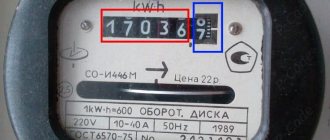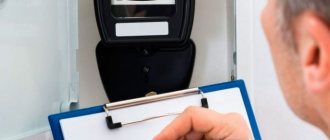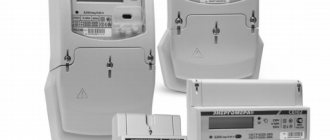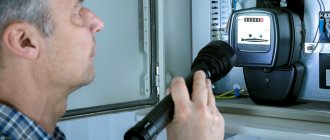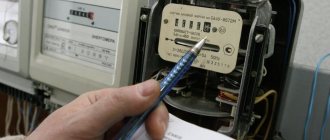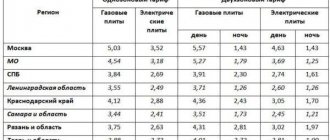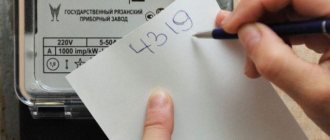With the advent of new modern metering devices, calculating electricity payments has become more complicated. For example, consumers often do not always understand how to take day-night electricity meter readings, because this device differs in operating principle from the usual single-tariff ones in that it records consumption at several tariffs. Since the maximum amount of energy is spent during the day and evening, in order to reduce the load on substation equipment, different rates were introduced for daytime and nighttime consumption. The night rate is significantly lower. Thanks to this, consumers can save significantly, and the supplying organization reduces the load on the network.
How to pay for electricity if the meter has been changed?
If the electric meter has been replaced, and when making payment it has not yet been taken into account in the payment acceptance database due to the operational need for time to go through documents for replacement and making changes to the calculation base, then the subscriber can pay the amount consumed for the billing period to be paid...
Interesting materials:
How to define an adverb into a phrase? How to determine whether red caviar is real or not? How to determine whether a fur coat is real or not? How to identify real country butter? How to identify a real Casio watch? How to determine whether eggs are real or not? How to identify real ginger? How to identify real fur in shoes? How can you tell if a Reebok is real or not? How to determine whether a ruby is real or not?
Taking readings
How to correctly take day/night electricity meter readings - to do this, just carefully study the readings displayed on the digital display.
First of all, pay attention to three designations - T1, T2. You can switch between them using the “Enter” button (in some models - “Prcm”), and some models also provide automatic change of display mode every few seconds.
Here's how to read a two-tariff meter:
- Write down the readings under T1 (this is the day).
- Write down the readings under T2 (this is night).
- On the sheet of paper under these indicators, write down the same indicators for the previous month.
- Subtract the second from the first numbers to find out the number of added kilowatts.
- Calculate the amounts to be paid for both tariffs. To do this, the number of kilowatts in each column is multiplied by the cost of one kilowatt (usually indicated on the receipt).
- Sum the resulting two numbers.
You should pay the resulting amount to the company supplying electricity. As you can see, taking readings from the electricity meter is not at all difficult. However, there is one additional nuance to consider that is often forgotten.
When recording readings, you should not take into account the numbers located after the decimal point or period. They are not whole kilowatts. If you forget about this and count with them, you will have to pay significantly more than necessary. If you have an old device, then there may not be any comma on it. Then be sure to write down all the numbers.
The above algorithm approaches how to take readings from the Mercury-200 electricity meter, that is, one of the most common models of household metering devices today.
Perhaps you have a Saivan single-tariff meter installed at home. It has extremely laconic functionality - for example, it does not have a button for switching tariffs, so you need to wait 5-10 seconds each time until the next value appears. The following data is displayed on the Saivan device display (in order):
- The current date;
- time;
- device identification number;
- disk rotation speed (how many times it will turn in 1 kW, the average is 1600);
- for a two-tariff meter - changing readings T1/T2, for a single-tariff meter - general TOTAL.
Both individual and general indicators are entered in the receipt. Numbers after the decimal point are not taken into account.
Taking readings from three-phase meters
A rather rare “beast” among household metering devices is a three-phase electric meter. There are two types of them - the older one (working with the help of a transformer) and the newer one (electronic, independent of the transformer). The process of taking readings electronically is no different from that described above.
The situation is a little different with older models, as well as with those that are allocated too much power, requiring a transformer. To find out the exact data from such an electric meter, you also need to know the transformation (conversion) coefficient. The information displayed on the screen is multiplied by this coefficient, only then is true information about consumption obtained.
It is also advisable to study the service agreement. As a rule, all stages of the calculation are described in detail. And in some companies, it is enough for the user to enter data on the readings and transformation coefficient into the receipt, and the operator himself will calculate the total. All this needs to be clarified at the very beginning of using the meter.
How to find out indicators for more than a whole month
If you wish, you can take data not only for a calendar month, but also for any other period, even a minute. Find an inscription on the device indicating the rotation speed of its disk (for example, 600 or 1200 revolutions per 1 kilowatt).
The disc is always equipped with a special red mark that allows you to track the turnover. Observe the wheel for a minute or other period of time and roughly count the number of revolutions. Then it’s a matter of small calculations - for example, if the wheel turned 300 times per minute, then during this time 300/600 = 0.5 kilowatts of electricity were consumed.
What to do next with the collected indicators?
Having learned how to read meter readings, it would be a good idea to remind you where to send them next. First, write them down on your electricity bill. In the case of a division into day and night tariffs, the readings must also be entered separately, but paid in total.
There are three ways to deliver information about your electricity costs to the service company:
- Online (via the company’s official website or using the Sberbank Online service). For the second method, use the details indicated on the receipt.
- Take the receipt in person. Payment is accepted both at the office of the organization itself and at most large banks.
- If you purchase a more expensive model of an electric meter, it will have a function for automatically transmitting readings. In this case, you won’t need to count anything, but you still need to pay for incoming receipts.
Let's take a closer look at remote readings. Meters with this function are relevant, for example, for housing landlords. The data from them is transmitted to the service company via the Internet and analyzed there. But the functionality is not limited to this - if there are completely exotic models that support:
- forwarding notifications;
- remote connection or disconnection of consumers;
- calculation in accordance with different tariff zones.
Such a system has a number of advantages. The main thing is that changes in readings are recorded daily and are always stored in memory, which makes it easy to resolve any controversial situation. You can use special programs to monitor energy consumption remotely, for example, while on vacation.
The readings given by such modern meters are distinguished by a high level of accuracy - there are no errors even when tariffs change. Finally, the function of remotely turning off the power in the apartment is convenient - this is if you left and suddenly doubted whether you turned off the iron.
Tariff "night"
Night time is considered to be eleven o'clock in the evening - seven o'clock in the morning. At this time, you can turn on devices that consume a large amount of energy.
Before installing a multi-tariff meter, you need to understand exactly whether there is a need for it. If more electricity is wasted during the day, but at night its consumption is insignificant, there is little point in it. It is worth determining what equipment can be used at night in order to save money. Based on the energy price set in a given region, the approximate cost of consumption can be calculated. Based on the benefits that you plan to receive, you can decide on the advisability of installing such a device and its payback period.
Manufacturers and prices
Electricity meters of any type are single-phase and three-phase. Two- and multi-tariff too. There are no differences in this, as well as in appearance. The difference is usually in price, but this is understandable - more complex equipment has a higher cost.
The most in demand on the market are two-tariff electricity meters from the Moscow Electrical Instruments Plant (MZEP). It’s not so much about the quality (it’s average, by the way), but about the price - these are the most inexpensive metering devices of this type. The company produces two-tariff energy meters SOE-55. They are available in eight modifications. They differ in the maximum current they are designed for and the number of zones that can be programmed. Any model can have two types of housings: for installation on a Din-rail or in a special box. The price of two-phase electricity meters SOE-55 is from $20 to $30, and this is in the retail chain.
Two-tariff energy meters SOE-55 in two cases - on a DIN rail and in a box
Energomer meters are available with the marking 102 in 4 modifications, with the marking 208 - in two. Each of the modifications can be made in several housings - a standard one for mounting in a box and one with protrusions for a DIN rail. There is also a housing with a remote reading indicator.
According to reviews, the units are quite good; products of this brand are distinguished by powerful terminals for connection, which is always good. They also have a warranty period of 5 years from the date of issue. In terms of prices - simple models cost about $23, with a remote control - $130.
Two-tariff electricity meter Energomera CE 102
Quite popular products from Moscow are Mercury counters. There are three modifications of multiphase meters of this brand: Mercury 200, 203 2T, 206. They can count 4 different tariffs, it is possible to program up to 8 zones per day, set 8 types of days (sometimes weekends and holidays are also counted at a reduced tariff). It is possible to set up to 12 seasons. Cost from $25 to $70 (depending on the degree of sophistication).
Meter Mercury 200 for electricity metering at two (three) tariffs
A two-tariff electricity meter is connected in the same way as a single-tariff one. There is no point in dwelling on this, everything is described here .
Induction meters
This process for old-style devices is quite simple; it is enough to rewrite the information from the mechanical indicator, where the numbers display the total amount of electricity consumption over the entire period of operation of the device. After this, the readings for the previous period are subtracted from the resulting number. The result is multiplied by the current tariff.
The information is included in the payment receipt. Once every six months, energy companies have the right to monitor the metering device, which obliges the consumer to provide access to it.
Induction meter readings with drum
In the figure above, the segments of the mechanical indicator that display an integer are marked in red, and tenths of kilowatt-hours are marked in blue. There are models without displaying the fractional part. The meter's rated current, voltage, and frequency parameters are shown below. By the rotation speed of the drum, you can visually assess the current load power.
Important! Tenths are not included in the receipt.
Induction devices are gradually being replaced by electronic ones due to their undoubted advantages. Let's tell you what they are.
Standard electricity meter readings
In order to correctly use a multi-tariff meter and learn how to save with it, you need to understand what the indicators on the device display mean and how to write them off correctly.
Two-tariff devices usually distinguish two zones:
- Daytime – from 7 am to 11 pm at the standard rate;
- Night - from 11 pm to 7 am at a reduced cost.
The first number after the letter “T” shows what time is currently in effect. Daytime is designated “T1”, and nighttime is designated “T2”. The second digit after “T” shows the payment code that must be indicated when paying for use – day, “2” – night.
If you have a three-tariff meter, then the time distribution will be as follows:
- Rush hours are in the morning from 7 to 10 and in the evening from 17 to 21;
- Semi peak - from 10 to 17 hours and 21 to 23 in the evening;
- Night time with the lowest tariff is from 23 to 7 am.
Based on the allocated zones, payment is made, where during rush hour you usually pay 50% more than the regular tariff, during half-peak - according to the tariff, and at night - 60% less.
And since we already have three indicators, there will also be three designations: “T1” – rush hour (payment code 13), “T2” – night (payment code 2) and “T3” – half-peak (payment code 15).

